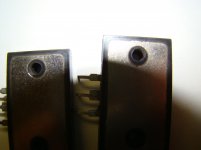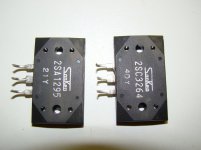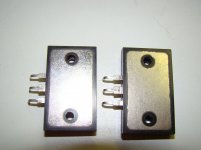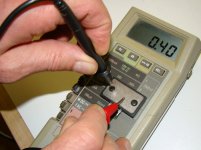the -2 version says it has a 3mil Kapton film inside.
That will be a pretty poor thermal conductor.
I'd say that would only be suitable for low powered devices.
The Mica supplied by Sanken is 0.004" thick and it cools fine. The extra surface area of a MT-200 device helps with cooling. No need for super thin easily damage pads.
Jeff,
For the modular board sets do you have the part numbers for the 6 pin male/female connectors that go from the input to the output board?
For the male pin header, Molex 22.28.4067 will work.
For the female header I use TE 5-146763-8.
Thanks Jeff. Seems like I should have been able to find that part myself.....
Andrew, I compared the insulating sheet I am looking at to the Keratherm that is sold by the DIY audio store. They are in a different league. The Tguard available in sheets from Mouser has a thermal resistance of either .84 or 1.42 degrees C-cm. sq /watt depending on thickness. The keratherm is 35 degrees C-mm sq/watt. Making mm sq to cm sq looks like .35 degrees C-cm sq/watt. Even the thinner Tguard is more then twice the thermal impedance. If I knew where to buy Keratherm in sheets or for the MT200 transistors I would... looks like I will have to settle. this is a class A/B amp running modest bias.
Andrew, I compared the insulating sheet I am looking at to the Keratherm that is sold by the DIY audio store. They are in a different league. The Tguard available in sheets from Mouser has a thermal resistance of either .84 or 1.42 degrees C-cm. sq /watt depending on thickness. The keratherm is 35 degrees C-mm sq/watt. Making mm sq to cm sq looks like .35 degrees C-cm sq/watt. Even the thinner Tguard is more then twice the thermal impedance. If I knew where to buy Keratherm in sheets or for the MT200 transistors I would... looks like I will have to settle. this is a class A/B amp running modest bias.
Keratherm is exceptional. I don't know of a competitor that can match them yet.
1mil Kapton and 1mil mica beat most other soft insulators. Some are almost their equal but a few are far worse.
You have the be selective and that depends on the duty your build requires.
If you have a To247 dissipating an average of 2W, then it hardly matters whether Rth c-s is 0.2C/W, or 2C/W
But you are in a new scenario if you want to dissipate 30W, or more in a device.
1mil Kapton and 1mil mica beat most other soft insulators. Some are almost their equal but a few are far worse.
You have the be selective and that depends on the duty your build requires.
If you have a To247 dissipating an average of 2W, then it hardly matters whether Rth c-s is 0.2C/W, or 2C/W
But you are in a new scenario if you want to dissipate 30W, or more in a device.
A quick thermal pad update. I ordered a sheet of silpad K10 from digikey.
Sil-Pad K-10 Properties ~ Thermal Materials, Thermal Solutions ~ Henkel
I also spoke with MH&W International Corp. They are sending me a sheet of Keratherm red 86/82. They were pleasant and happy to send out a small quantity. Not cheap but within reason.
Sil-Pad K-10 Properties ~ Thermal Materials, Thermal Solutions ~ Henkel
I also spoke with MH&W International Corp. They are sending me a sheet of Keratherm red 86/82. They were pleasant and happy to send out a small quantity. Not cheap but within reason.
I could use a piece of each for two channels and see if there is any difference in transistor temperature
A sheet of the silpad showed up today so I was able to assess the damage to the bad amp.
With a new insulator in place I was still measuring continuity from the output devices to the heatsink???? There must have been some metal that migrated from the transistors backside up into the bolt holes, there is continuity from the transistors metal tab to the inside of the bolthole in the transistor.
I replaces the two outputs that showed they had arced and the amp works fine. Tomorrow I will preemptively take the other channel apart and replace the silver goo and mica with the silpad.
With a new insulator in place I was still measuring continuity from the output devices to the heatsink???? There must have been some metal that migrated from the transistors backside up into the bolt holes, there is continuity from the transistors metal tab to the inside of the bolthole in the transistor.
I replaces the two outputs that showed they had arced and the amp works fine. Tomorrow I will preemptively take the other channel apart and replace the silver goo and mica with the silpad.
Evan, sounds good. Interesting, rather non-standard experience, useful for all the power amps builders 

Amazing. I've seen some really exploded/burnt MT-200 transistors, conducting C-to-E, but I've never seen the ones, looking good, conducting plate-to-hole 😱
I can't see anything in side that looks suspicious. I guess 140 volts and a lot of capacitance can do funny things.
I think you may have a layer of carbon inside the screw holes from the blow out. The interior of the screw holes should be epoxy. I wonder if the devices actually survived otherwise? Do you have a small file or close fitting drill bit that you can run through the screw holes and remove a bit of material, then recheck for continuity?
I think your correct about the devices still working. I gave a try at cleaning up the bolt holes with a small file. The epoxy around the bolt hole is crumbly/chalky. I decided to just replace the two devices.
It's amazing how hot an arc is and how much that heat can affect things. I'm fixing up a couple old video games right now. One board had a drip off someones boot land on a triac (terrible design by Sega). The epoxy of the board charred through to the opposite side of the board and was conductive.
I can't see anything in side that looks suspicious. I guess 140 volts and a lot of capacitance can do funny things.
It's at least to my eyes evident the plastic has become charred and thus become conductive, you have to grind of that thoroughly.
Last edited:
It's cool that the whole system has demonstrated rather high reliability - nothing broke, except those two transistors, that experienced the arc - even those two are ok, except some areas of their plastic case became conductive 
Another live test of 21-st century control board within the solid build

Another live test of 21-st century control board within the solid build

$13.00 worth of transistors and $35.00 for the sheet of silpad. Not bad at all.
Again I am very glad for the protection circuit. My system no longer uses any crossover parts between the amps and the speakers. The ribbon and super tweeter on that channel would have certainly been toast. In one incident the amp controller more then paid for itself.
As far as making a semiconductor..... I'll leave that to the pros
Again I am very glad for the protection circuit. My system no longer uses any crossover parts between the amps and the speakers. The ribbon and super tweeter on that channel would have certainly been toast. In one incident the amp controller more then paid for itself.
As far as making a semiconductor..... I'll leave that to the pros
- Home
- Amplifiers
- Solid State
- Revisiting some "old" ideas from 1970's - IPS, OPS




